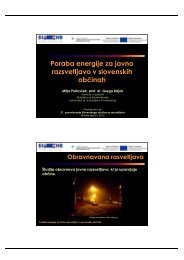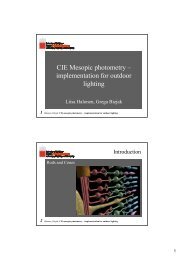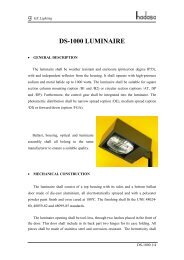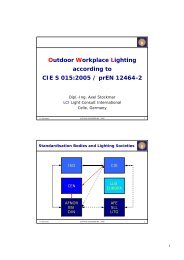Zbornik - SDR
Zbornik - SDR
Zbornik - SDR
You also want an ePaper? Increase the reach of your titles
YUMPU automatically turns print PDFs into web optimized ePapers that Google loves.
“ Energy efficiency in INTERIOR Lighting – a Romanian Case Study ” R-3<br />
the windows; obstruction density and reflection; windows transmittance and dimensions; windows<br />
on one or two sides of the room. The results show important drops in average illuminance till 60%,<br />
which is a factor of concern for offices real illuminance.<br />
Influence of the time of the year and obstruction type. Figure 1 shows the OL fluctuations during<br />
a day, from 8 a.m. to 4 p.m. for January, April, July and October 15th. It can be seen from these<br />
charts that OL for overcast sky is constant, but for clear sky there are high fluctuations. It also can be<br />
noticed that no matter the sky type, the OL are lower around 10 and 12 a.m., when sun altitude is<br />
near the maximum. From here a dependence relation between sun altitude and OL for South and<br />
West windows. For North windows there are minor daily fluctuations for clear and partially clear<br />
sky.<br />
The chart shapes are changed for each period of the year. In some periods of the year, at 8 a.m.<br />
there are the highest OL, and in other periods there are the lowest OL The illuminance level reduction<br />
for overcast sky is not dependent of the time of the year, with average values of 32.81% for heavy<br />
obstructions, 27.37% for medium obstructions and 12.3% for light obstructions. In the morning, for<br />
partially overcast or clear sky and for North or West window orientation, illuminance reduction is not<br />
significantly influenced by the time. The highest fluctuation of illuminance reduction for 10 a.m.<br />
appears in the case of South or East windows, with a peak in the winter.<br />
Figure 2: Obstruction Losses as<br />
function of VFR || , VFR ⊥ and VFR (for<br />
overcast sky)<br />
Influence of obstruction orientation in relation to the window. In the studies about obstructions in<br />
the case of electric lighting the Vertical to Floor Ratio – VFR factor was introduced as an expression<br />
of room content [5]. VFR is the ratio between obstructions vertical surface area above the floor area.<br />
We proposed for daylight to decompose VFR in VFR || for parallel surfaces with windows, and VFR ⊥<br />
for perpendicular surfaces with windows. (NB: VFR || + VFR ⊥ = VFR). When the obstructions are<br />
rotated with 90°, the VFR || and VFR ⊥ swap, VFR remains constant, but OL drops in average with<br />
3.6% for overcast sky and heavy obstructions and with 4% for partially overcast and heavy<br />
obstructions. So, the OL for overcast sky can be interpreted as function of VFR || , VFR ⊥ and VFR. The<br />
chart from Figure 2 shows that the trend is different from the linear slope of OL/VFR, which is<br />
characteristic for electric lighting. However there is a relation of proportionality between VFR and<br />
OL, especially for light and medium obstructions, but which is no longer valid for heavy obstructions<br />
(presence of partitions). Despite these problems, the simulations have proved that a reduction of<br />
obstruction density lead to smaller OL, as the orientation of partitions from parallel to perpendicular<br />
to windows wall.<br />
“Lighting engineering 2006” stran 15
















